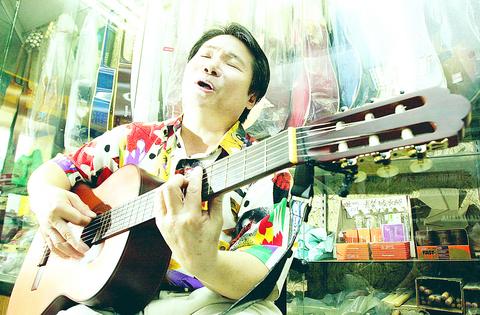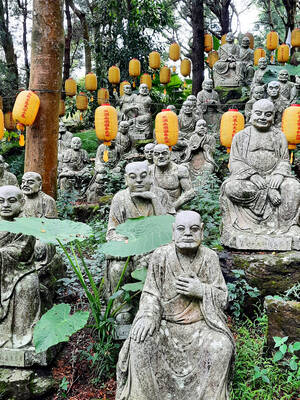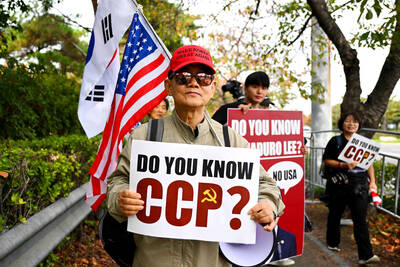While traditional Taiwanese pub-rock was a cry from the folksy/pop-laden style of music that was to make Wang Ying-tan (
Wang and Lee hit the headlines in 1997 after their album, Walking to Tamsui (
"I figured we'd possibly sell about 200,000 copies of the CD. I was told by company executives, though, not to spend too much money on them as they thought the album would flop and only clock up sales of between 30,000 and 50,000 ," said Landy Chang (

PHOTO: CHEN CHENG-CHANG, TAIPEI TIMES
For 28 years prior to being spotted by singer/songwriter Chen Ming-chang (
When Wang died unexpectedly of a heart attack early last month Taiwan not only lost one half of its most unlikely pop acts but many of the nation's nakashi musicians feel that it also laid to rest one of the very few remaining vestiges of Taiwan's hybrid form of pub rock.
While there are many stories surrounding the history of nakashi, according to Tsan Yi-cheng (

PHOTO COURTESY OF MAGIC STONE
"Nakashi originated in port towns such Tamsui and Keelung. Japanese sailors would come ashore and, being sailors, frequent bars. Of course there were no tape or CD players, so the sailors had to make their own entertainment," Tsan said. "So they performed music which took on aspects of enka, or Japanese country music and filled it with lyrics about roaming the world and having a girl in every port."
According to Tsan, the result of this odd musical coupling was unlike anything people in Taiwan had ever seen or heard before. Until the Japanese sailors came along, local pub and teahouse bands were still using traditional Chinese classical instruments rather than western ones.
"With their guitars, accordions and appetite for good times, Japanese sailors revolutionized bar and teahouse music in Taiwan," the Peitou-based nakashi star said. "They enthralled crowds in teahouses and bars and, of course, drove the women wild with their contemporary musical style." As Japan's colonization of Taiwan continued, nakashi slowly became the music of choice for both the occupying forces as well as the Taiwanese.
As more locals began to pick up accordions and guitars, however, nakashi slowly became localized. Instead of drawing on enka for inspiration, Taiwan's nakashi players added elements of Fujienese and Taiwanese folk to the tunes.
Even after Japan surrendered to the Allied Forces in 1945 and popular North American culture began to influence Taiwan, nakashi continued to prove incredibly popular. So much so that by the late 1950s, local nakashi musicians had built up substantial fan bases.
"It sounds a bit odd, but we were like pop stars. We didn't release records, but people still stopped us on the street to say `hello.' And the women, well, some of the guys used to have a different one in each of the bars or teahouses they played," said Chen Sen-chun (
Although many of the tunes the men of nakashi performed were simply cover versions of other people's songs, they certainly weren't averse to penning their own creations -- many of which, although far from political, were awash with social commentary.
"It was illegal to say rude things about the government, but the guys used to fill the songs with humorous tales of Taiwanese society," said Chung Chen-ta (鐘成達), a member of the award winning-band, Labor Exchange (交工樂隊) and a student of nakashi. "I figure that as most of the cover versions they performed were about love, the change in lyrics and topics was a great relief to many of them. After all, there's only so many times you can play someone else's song without getting frustrated and bored."
By the mid-1980s, many of the nakashi acts had disappeared from teahouses and bars in Tamsui and Keelung, and with urban renewal programs seeing parts of the Wanhua district of Taipei leveled, the nakashi men were slowly running out of venues in which to perform. The only place nakashi continued to prove popular was in Taipei's northern suburb of Peitou, where nakashi acts could be caught performing until as recently as the mid-1990s.
"I guess it has a bit to do with the Japanese influence in Peitou remaining so strong. But I reckon what really killed off nakashi was when the old bath houses and hotels went up market, installed karaoke machines in the rooms and tried to shed their seedy images," Tsan said.
With a lack of venues from which to ply their trade, people like Tsan and Chen are now finding that the only time they get to perform their music is for the media.
"There's not much demand for nakashi performers anymore, as the hotels and bars all have karaoke machines, which are cheaper than employing a band. And of course the customers don't have to tip," Chen said. "About the only time we perform now is when a television channel is producing a documentary."
While it could be argued that the death toll rang for nakashi many years before Wang's death, Chen feels that the popular musician's passing has destroyed any possibility of a nakashi revival.
Magic Stone's Chang agrees.
"I don't think it is possible that a band would be able to pull off what the King of Kinmen did, as the sense of Taiwanese-ness is not as strong anymore," Chang said. "With the DPP in power and martial law long lifted, there is little call for Taiwanese-ness. It's like nobody cares about such things anymore."
The same cannot be said of Japan, however, where its form of nakashi, is enjoying a resurgence in popularity, especially among the young.
"In Japan, enka music has recently become pretty popular, with NHK and other TV stations airing programs about enka music," Hsiao Ying (
According to Ying, there is little chance of Taiwan's fashion-conscience Generation X-ers taking a sudden interest in the music that their grandparents grew up with. "Japan's kids are much more open to different forms of music. They don't snub their noses in the air and dismiss something simply because it's unfashionable or old like they do in Taiwan," he said. "It's a pity. Nakashi is a crucial part of Taiwan's musical history, and one that should not be forgotten, ignored or replaced by other forms of music simply because they're more fashionable."

US President Donald Trump may have hoped for an impromptu talk with his old friend Kim Jong-un during a recent trip to Asia, but analysts say the increasingly emboldened North Korean despot had few good reasons to join the photo-op. Trump sent repeated overtures to Kim during his barnstorming tour of Asia, saying he was “100 percent” open to a meeting and even bucking decades of US policy by conceding that North Korea was “sort of a nuclear power.” But Pyongyang kept mum on the invitation, instead firing off missiles and sending its foreign minister to Russia and Belarus, with whom it

When Taiwan was battered by storms this summer, the only crumb of comfort I could take was knowing that some advice I’d drafted several weeks earlier had been correct. Regarding the Southern Cross-Island Highway (南橫公路), a spectacular high-elevation route connecting Taiwan’s southwest with the country’s southeast, I’d written: “The precarious existence of this road cannot be overstated; those hoping to drive or ride all the way across should have a backup plan.” As this article was going to press, the middle section of the highway, between Meishankou (梅山口) in Kaohsiung and Siangyang (向陽) in Taitung County, was still closed to outsiders

President William Lai (賴清德) has championed Taiwan as an “AI Island” — an artificial intelligence (AI) hub powering the global tech economy. But without major shifts in talent, funding and strategic direction, this vision risks becoming a static fortress: indispensable, yet immobile and vulnerable. It’s time to reframe Taiwan’s ambition. Time to move from a resource-rich AI island to an AI Armada. Why change metaphors? Because choosing the right metaphor shapes both understanding and strategy. The “AI Island” frames our national ambition as a static fortress that, while valuable, is still vulnerable and reactive. Shifting our metaphor to an “AI Armada”

The Chinese Communist Party (CCP) has a dystopian, radical and dangerous conception of itself. Few are aware of this very fundamental difference between how they view power and how the rest of the world does. Even those of us who have lived in China sometimes fall back into the trap of viewing it through the lens of the power relationships common throughout the rest of the world, instead of understanding the CCP as it conceives of itself. Broadly speaking, the concepts of the people, race, culture, civilization, nation, government and religion are separate, though often overlapping and intertwined. A government